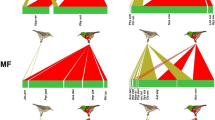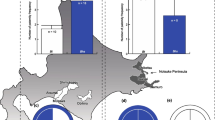Abstract
Protandry (the emergence of males before females) is currently explained either as a mating strategy to maximize number of matings in the males, or a way to minimize pre-reproductive mortality in females. Models of protandry have generally ignored variation in female quality (reproductive potential). We recorded the sex ratio, female body mass, wing length and potential fecundity (number and mass of eggs) of the tropical butterfly Brassolis sophorae through the emergence period. Temporal variation in female size and fecundity correlated with male potential for acquiring mates. Females from the end of the emergence period showed lower fecundity and size. Males emerging before and close to the median date of the female emergence period had greater mating opportunities. Males emerging either very early or late were penalized by few mating opportunities, or by encounters with small, low-quality females, respectively.
Similar content being viewed by others
Author information
Authors and Affiliations
Additional information
Received: 14 November 1997 / Accepted: 23 March 1998
Rights and permissions
About this article
Cite this article
Carvalho, M., Queiroz, P. & Ruszczyk, A. Protandry and female size-fecundity variation in the tropical butterfly Brassolis sophorae . Oecologia 116, 98–102 (1998). https://doi.org/10.1007/s004420050567
Issue Date:
DOI: https://doi.org/10.1007/s004420050567




